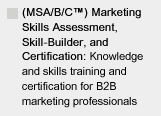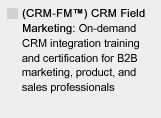MAKE SURE YOU CONTINUE TO RECEIVE EACH ISSUE OF TUESDAY MARKETING NOTES—CLICK HERE TO RENEW YOUR FREE SUBSCRIPTION (NOTE:IF YOU'VE ALREADY SIGNED UP TO RECEIVE TMN, NO NEED TO SIGN UP AGAIN.)


The Marketer’s Action Plan (MAP): Six Steps to Developing Effective Marketing Plans
in B2B Marketing Programs
by Eric Gagnon
Business-to-business marketing professionals are always interested in finding better tools to help them create marketing plans that generate better, and more measurable, response. In our BMI online CRM Field Marketing (CRM-FM) training and certification program, we’ve developed the Marketer’s Action Plan (MAP), a step-by-step process for helping you plan, develop, execute, measure, and adapt any marketing activity.
While intended for use with CRM systems, where measurement of marketing programs (also known as "campaigns" in most CRM systems) is made far easier by tracking them within CRM, you don’t need to use a CRM system to implement this process in any marketing plan.
Even better, the Marketer’s Action Plan can be used for any marketing activity that is part of your overall marketing program—from print advertising, to direct mail, trade shows, or online-based marketing activities. The MAP helps you develop an organized mindset for solid execution, and a discipline for measurement in every marketing project you develop for your company or client.
The Marketer’s Action Plan (MAP) describes the six stages in the process of marketing execution using on-demand CRM to plan, execute, measure, monitor, and improve your marketing plan. This action plan describes both the general execution steps required to develop and execute any type of marketing project as a campaign in your CRM system, and the actions required over the process of the campaign to insure that leads are properly tracked and measured for a campaign, and then moved along into your lead development program, where diligent coordination between you and your sales team helps to convert as many of these prospects into customers, over the length of your sales cycle.
This action plan also accounts for the all-important final step of assessing and improving poor sales response for a campaign which is likely to occur during implementation of your marketing program.
Steps in the MAP Process
Using MAP, the planning, execution, and management stages for any individual marketing activity can be broken down into six action steps for any marketing project (campaign) in any on-demand CRM system, as follows:
1.) Create Your Plan;
2.) Plan for Measurement;
3.) Execute;
4.) Track, Measure, Monitor, and Assess;
5.) Evaluate, Adapt, and Improve;
6.) Follow Through
Step 1.): Create Your Plan
Marketing is mostly tactical: There are formal marketing plans and there are informal ones, but for marketing professionals in the real world, the best plan is a set of tactical marketing projects (CRM campaigns) you can develop and put into action immediately to meet the marketing opportunities that generate sales response for your company.
After all, when everyone gets up from the table from the marketing planning meeting, what’s left is a list of tactical activities that must be executed: Ads, mailings, trade shows, and the other marketing projects that must be developed and executed. Each of these tactical activities is a campaign in your on-demand CRM system, and the complete schedule of these campaigns comprises your marketing plan. The MAP helps you optimize each of these tactical activities for maximum sales response and measurability.
Define your campaign’s objective: The first action planning step is to define the objective (or goal) of the campaign. Nearly always, this can be expressed as a description of the execution of the marketing project (campaign) at hand, tied to the goal to be accomplished by this project.
For example, the execution of any specific direct mail campaign is to develop a mailing targeted to one or more identified mailing list(s), to meet the goal of generating measurable sales leads for followup by your company’s sales team; for a trade show, the purpose of the execution is to draw potential prospects to your booth at the show, qualify and capture their contact information, with the goal of generating a measurable number of leads to be followed up with by your company’s sales reps after the show.
Define your prospect targeting: Once the objectives have been established for the campaign, the next step is to identify the types of individuals your campaign must reach. This is a process of targeting these individuals, by job title, purchasing responsibility, trade publications read, trade shows attended, or some other means which is identifiable by a marketing medium (trade publication, trade show, mailing list, keyword search program, etc.) to identify one or more groups of potential prospects who might buy your company’s products.
Just as an experienced sales professional knows how to identify the most likely buyers at a company for his or her product, as well as identifying the other “influencers” who also must be convinced to buy the product, prospect targeting reduces your market to the universe of potential buyers who are more likely to be interested in buying, using, or applying your product than other individuals in your market.
Some marketing methods, such as direct mail and keyword search text advertising, can be used to target the kinds of prospects you want to reach more precisely than other methods, such as print advertising or trade shows. For example, if you’re involved in a market test to determine who your prospect is, your targeting may be broad; if you know your market, you are better off targeting prospects as precisely as possible, since you’re also very likely to know who buys your company’s products and where they work in your market.
Sometimes, even if incorrect prospect targeting was the cause of an underperforming campaign, this campaign may eventually lead you to better targeting on subsequent marketing efforts, as you learn, from the few prospects who did respond to your ad, mailing, or other campaign, who are the better prospects to reach with your marketing efforts.
Once defined, prospect targeting then dictates every other aspect in the development of your marketing program and its deliverables, such as sales copy, presentation, positioning, and the promotional offer used in the campaign. Defining your objectives and your targeting also helps you to decide on (or confirm) the best marketing method to use for your campaign.
Planning for lead development: Of course, most products sold in business-to-business markets are complex and expensive, which means they often require a fairly lengthy sales cycle. During this period, which may span many months (or even a year or more), consider what happens to a lead after it is generated by your campaign. If you already have a lead development program in place, determine whether leads generated from the campaign you’re planning should flow into your existing lead development program, or if prospects who reach you from this campaign are different in some way (such as their job title or technical background) that justifies sending them different messaging deliverables for lead development. Plan ahead for these changes, so you’ll have the necessary deliverables (white papers, etc.) developed and ready as leads arrive from your campaign.
Step 2.): Plan for Measurement
After you have defined your objective and your prospect targeting, give careful thought to how you are going to measure your campaign. The best and usually the only worthwhile way to measure a campaign is sales response: Counting the number of leads who respond to your ad or mailing, provide their contact information in your company’s booth at a trade show, or fill in their e-mail addresses on one of your Web landing pages in response to your keyword search advertising.
Measuring sales response is only the first step in effective campaign measurement: Because on-demand CRM systems allow you to track every new sale all the way back to the original campaign that generated the lead which eventually led to the sale, you can also use your CRM system to track any campaign’s overall return on investment (ROI); this is one of the most powerful features of on-demand CRM systems.
Develop a promotional offer: As you can see, calculating return on investment in on-demand CRM campaigns can only happen once sales response is generated, but another important task at the planning stage of every campaign as a marketing professional is to determine not just how prospects will contact your company, but to develop the means by which they’ll be motivated to respond. You could rely solely on the persuasive power of the strong, compelling copy and benefits used in your ad or mailing to motivate prospects to contact you, but you can increase your chances of generating solid sales response by providing “something extra:” An information premium, promotional offer, or other ”call-to-action” offer that motivates potential prospects to contact your company sooner instead of later (which usually means “never”).
Associating leads to a campaign: Wherever there is a known universe of potential prospects identified and in your possession, such as a mailing list, or a list of selected leads already in your on-demand CRM database, the next step in planning to measure is linking, or “associating” these identified potential prospects to your campaign. By associating these records to the campaign, you make it easy to match up the prospects who respond to the campaign to their corresponding linked record in your CRM system; these matches count as sales response, which is the first step in measuring a campaign’s effectiveness and final return on investment.
The final step in planning for measurement is to insure that leads received from a campaign will be captured to your CRM system, either by sales reps or administrative staff, who receive phone calls, e-mail, or reply cards from prospects who respond to a campaign, from trade show contacts, online, or from Web landing pages on your Web site. This step occurs both during this stage and during execution of the campaign in the next stage.
Step 3.): Execute
Marketing execution defines all the steps involved in the process of developing any marketing project. Marketing execution encompasses both the deliverables required, like ad layouts, direct mail packages, etc., and the critical process of completing every step in the process involved for every type of campaign.
Execution is the most important part of any marketing project that is a campaign in your CRM system and, next to the effective presentation of the deliverables used in the campaign, poor execution is often a major cause of failure in a marketing project. Solid, timely execution that gets your campaign delivered on time to meet the marketing or sales opportunity is such a critical aspect of the success of your marketing program using your company’s CRM system that most of the content of this workbook is focused on marketing execution.
The end result of all marketing execution results in completing your campaign and getting it in front of the prospects you’ve targeted in your market: Placing your ad in a trade publication to be received by its subscribers, dropping your mailing to its recipients, opening your booth at a trade show, and any other marketing activity that results in getting your deliverables in front of your potential prospects completes its execution and moves your action plan to the next stage.
Step 4.): Track, Measure, Monitor, and Assess
Once the campaign is executed, the process of inputting or capturing leads to your on-demand CRM system takes place. Contact information for a lead is captured by phone, e-mail, Web, or mailed-in reply cards, and matched to their associated record in the CRM campaign or, if a new lead, input or imported to your CRM leads database.
Useful measurement of marketing programs in an on-demand CRM system begins with accurate, diligent logging of leads generated to the CRM campaign responsible for generating the lead. At this stage, by carefully monitoring this process as leads are input, imported, and/or matched to existing leads associated to a campaign in your company’s CRM system, you can insure that all generated leads are linked to the campaign that created them. Once a lead can be linked to a campaign, the sales response of that campaign can be measured. If as many generated leads as possible can be precisely linked to this campaign, the more accurate its final measurement will be.
As leads arrive in response to a campaign, over time you can begin to assess the performance of the campaign, using the measurement criteria you established in the previous step 2.). You will usually be able to get a fairly good early indication of how much sales response is generated by the campaign over the first couple of weeks, and you can determine the total sales response to most marketing activities (i.e., number of initial leads generated from that campaign) well within 60 days of the date the first leads responded to that campaign.
Step 5.): Evaluate, Adapt, and Improve
Over time, and as most of the sales response is generated by the campaign, you can now more accurately project its final sales response, and get an early indication of its financial return. Since sales cycles for B2B products often go for many months between the time a lead is generated and before the prospect decides to buy, it may be difficult for you to calculate an accurate, final return on investment for a campaign, but you can determine the reasonably accurate final sales response (number of leads generated, and cost-per-inquiry) for a campaign after a few weeks. By comparing response to the campaign against response received from previous campaigns, by this time you will have a clear indication whether or not the campaign was successful, failed, or landed somewhere in between, relative to the other campaigns in your marketing plan.
Sometimes, and this is especially true for marketing efforts launched in new markets or industries, or for new product launches or startups, response from a campaign may fall well below your initial projections. The smart marketing professional prepares for this possible outcome, and knows the steps he or she must take to examine the positive and negative results of their underperforming campaign, find their underlying marketing (and, sometimes, product-related) causes, revise and improve the campaign, and, using effective execution, get the new campaign back online, as fast as possible, to generate better sales response on its next iteration.
Step 6.): Follow Through
As prospects respond to your campaign, as they are contacted and qualified by your sales team, they also enter into your lead development process: This is the marketing program that begins after the lead is generated, and which moves these interested prospects through the sales cycle. As your sales reps contact their prospects who have responded to a campaign, they learn more about the prospect’s business, their business problems, applications needs, product preferences, buying intention, and other issues as they relate to your company’s product.
During this process, sales reps provide the prospect with additional information on your company’s product from your CRM system’s document library, and give their prospect the opportunity to receive ongoing content from your company, in the form of opt-in e-mail newsletters and periodic technical, applications, and editorial information about your company and its product. This is all part of your ongoing lead development process, which is a combination of marketing activities including e-mail messaging programs, mailings, trade show and event promotions, and other marketing projects specifically targeted to prospects who, through this coordinated lead development effort by marketing and sales, are being moved closer to making their purchase decision in your company’s sales cycle.
By providing a systematic approach to every marketing activity, and by helping you to plan for measurement of every marketing activity early in the planning process, the Marketer’s Action Plan provides an organized framework for helping you to better plan and execute your marketing program.
Comments? Questions? Send them to me at: eric@businessmarketinginstitute.com
Eric Gagnon (eric@businessmarketinginstitute.com), a director with the Business Marketing Institute, is author of The Marketing Manager’s Handbook and The CRM Field Marketing Handbook.







